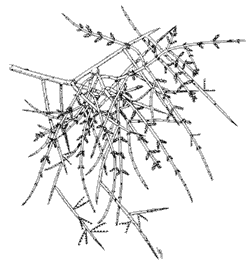Viscaceae (Loranthaceae) (mistletoe family)
Most of the 1000 worldwide mistletoe species are partial parasites. They have chlorophyll and thus photosynthesize, but take water and nutrients from their host plants.
Phoradendron californicum
English name: desert mistletoe
Spanish names: toji, toje, chile de espino (spine chile), guhoja
Description
Desert mistletoe is an essentially leafless plant with dense clusters of brittle, jointed stems. The winter flowers are inconspicuous but strongly fragrant. Female plants produce small red berries.
 |
Range
This species occurs in the desert from southern Nevada and California south to central Baja California and southern Sonora. The main host is mesquite; it is also found on other woody legumes and occasionally on Condalia and creosote bush.
Notes
Mistletoe berries are the main winter food of the Phainopepla (Silky Flycatcher). The seeds are extremely sticky and are deposited on other host plants when birds wipe their bills on branches or deposit droppings. A heavy infestation of mistletoe can damage or kill the host plant, but this is uncommon. Both the Seri and O’odham eat the berries, which are sweet when growing on most legumes, and rather bitter when growing on palo verde or non-legume hosts. The Seri made a medicinal tea from the stems.
Big-leaf mistletoe, Phoradendron macrophyllum (formerly P. flavescens in part), has true leaves and white berries. It parasitizes broadleaf deciduous trees, particularly cottonwoods, willows, and sycamore. Its white berries are bitter and poisonous.










